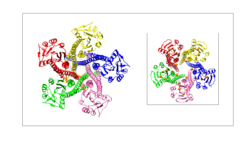Biology:Zinc transporter protein
Zinc transporter proteins (Zrt), or simply zinc transporters, are membrane transport proteins of the solute carrier family which control the membrane transport of zinc and regulate its intracellular and cytoplasmic concentrations.[1] They include two major groups: (1) the zinc transporter (ZnT) or solute carrier 30 (SLC30) family, which controls the efflux of zinc from the cytoplasm out of the cell and from the cytoplasm into vesicles; and (2) the zinc importer, Zrt- and Irt-like protein (ZIP), or solute carrier 39A (SLC39A) family, which controls the influx of zinc into the cytoplasm from outside the cell and from vesicles.[1] At least one zinc transporter, ZIP9, is also a G protein-coupled receptor and membrane androgen receptor.[2]
Families
ZnT (SLC30)
| Cation efflux (diffusion facilitator) protein | |||||||||
|---|---|---|---|---|---|---|---|---|---|
 ZntB Transporter Protein Structure: The left side of the image shows the full-length ZntB protein structure, without the presence of zinc. The right side shows the cytoplasmic domain of the protein and the apparent conformation change undergone by the protein to accommodate zinc transport. The conformation change is believed to be necessary for zinc ion transport. The chlorine ions (illustrated as the orange circles) support the conclusion that a change in the electrostatics and pH are necessary for transport.[3][4] | |||||||||
| Identifiers | |||||||||
| Symbol | Cation_efflux | ||||||||
| Pfam | PF01545 | ||||||||
| InterPro | IPR002524 | ||||||||
| |||||||||
Members: ZnT1, ZnT2, ZnT3, ZnT4, ZnT5, ZnT6, ZnT7, ZnT8, ZnT9, ZnT10
Bacterial members of the family are known to increase tolerance to high salt concentrations.
ZntB Zinc Transporter Protein
Unlike some other zinc transporter proteins, the mechanism of how Zn2+ is transported via ZntB is not well understood. However, scientists have been able to speculate that the transport of Zn2+ is related to pH gradient and the electrostatics of the protein membrane.[3][4]
ZIP (SLC39)
ZIP1, ZIP2, ZIP3, ZIP4, ZIP5, ZIP6, ZIP7 (Catsup), ZIP8, ZIP9, ZIP10, ZIP11, ZIP12, ZIP13, ZIP14
The structure of a bacterial ZIP protein has been resolved.[5]
References
- ↑ Jump up to: 1.0 1.1 "Physiological roles of zinc transporters: molecular and genetic importance in zinc homeostasis". The Journal of Physiological Sciences 67 (2): 283–301. March 2017. doi:10.1007/s12576-017-0521-4. PMID 28130681.
- ↑ "ZIP9, a novel membrane androgen receptor and zinc transporter protein". General and Comparative Endocrinology 257: 130–136. February 2018. doi:10.1016/j.ygcen.2017.04.016. PMID 28479083.
- ↑ Jump up to: 3.0 3.1 "The structural basis of proton driven zinc transport by ZntB" (in En). Nature Communications 8 (1): 1313. November 2017. doi:10.1038/s41467-017-01483-7. PMID 29101379. Bibcode: 2017NatCo...8.1313G.
- ↑ Jump up to: 4.0 4.1 "Structure and electrostatic property of cytoplasmic domain of ZntB transporter". Protein Science 18 (10): 2043–52. October 2009. doi:10.1002/pro.215. PMID 19653298.
- ↑ "Crystal structures of a ZIP zinc transporter reveal a binuclear metal center in the transport pathway". Science Advances 3 (8): e1700344. August 2017. doi:10.1126/sciadv.1700344. PMID 28875161. Bibcode: 2017SciA....3E0344Z.
 |

